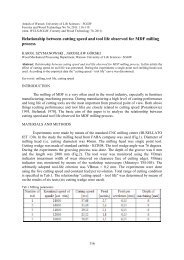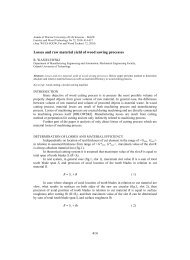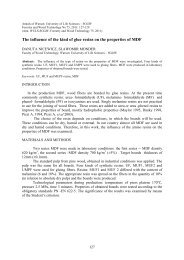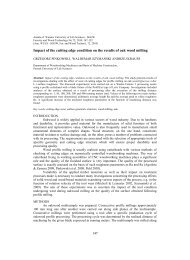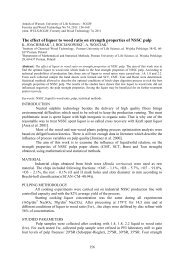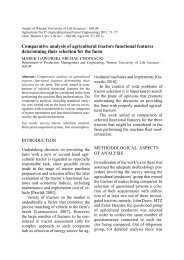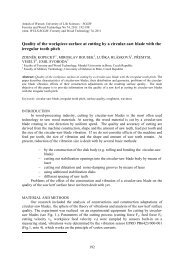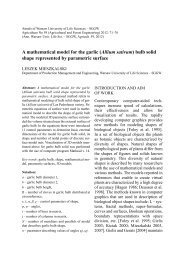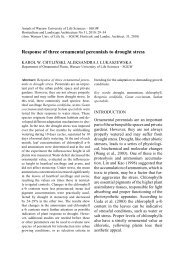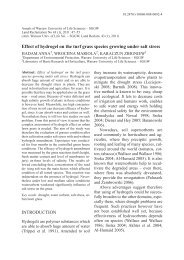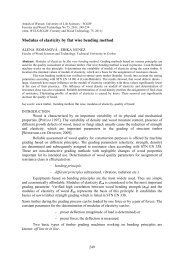Annals of Warsaw University of Life Sciences - SGGW
Annals of Warsaw University of Life Sciences - SGGW
Annals of Warsaw University of Life Sciences - SGGW
You also want an ePaper? Increase the reach of your titles
YUMPU automatically turns print PDFs into web optimized ePapers that Google loves.
company. However, we expect only a small probability <strong>of</strong> building <strong>of</strong> world companies<br />
branch stores, because steel companies have tendencies to expand into Asian countries, China<br />
or South American countries. There are barriers for entry <strong>of</strong> new competitors on the market;<br />
because <strong>of</strong> it the threat <strong>of</strong> entry <strong>of</strong> a new steel company on the market is slight. The entry <strong>of</strong><br />
new business into the branch is very demanding for capital, equipment, etc. Established<br />
companies use effect <strong>of</strong> learning process, experience, scale, what brings reduction <strong>of</strong> costs;<br />
they have established distribution channels, own distribution companies, what brings increase<br />
<strong>of</strong> barriers for the entry on the market.<br />
C. Pressure <strong>of</strong> substitutes<br />
Pipes from other material can be a potential substitute for steel pipes. Steel pipes are<br />
extruded by plastic pipes in the gas industry; for medium and low pressure distribution.<br />
Another possibility <strong>of</strong> modification <strong>of</strong> steel pipes is stainless pipes, aluminium or copper<br />
pipes, but their rate <strong>of</strong> substitution is questionable because <strong>of</strong> their prices. Due to the excellent<br />
properties such as hardness, strength, cutting properties, wear resistance, and heat resistance,<br />
steel is considered to be the best material which is 100% recyclable. The threat from the side<br />
<strong>of</strong> substitutes is rather presented by different brand or type <strong>of</strong> pipe. We can conclude that the<br />
threat, it means power <strong>of</strong> substitutes, is low.<br />
D. Bargaining power <strong>of</strong> customers<br />
The bargaining power <strong>of</strong> customers is proportional to the size <strong>of</strong> purchased volumes <strong>of</strong><br />
production. Customers put pressure to improve quality, reduce errors, improve the properties<br />
<strong>of</strong> used material, to shorten delivery terms and prolong maturity <strong>of</strong> the invoice. Manufacturers<br />
<strong>of</strong> cars, who buy precision welded pipes with small diameters, require mandatory<br />
certification. They have substantial bargaining power and push to ensure more flexibility in<br />
prices, quotation and more favourable terms <strong>of</strong> delivery. The analyzed company customers<br />
are mostly small but also large firms, which purchasing power is medium.<br />
E. Bargaining power <strong>of</strong> suppliers<br />
Suppliers <strong>of</strong> the main input (steel scrap) have stronger bargaining power than other<br />
suppliers. Suppliers have moderate bargaining power, because there are no substitute products<br />
<strong>of</strong> steel scrap; and the steel scrap is the strategic material, which is only in a limited amount.<br />
The Porter analysis results in determination <strong>of</strong> the competitiveness order <strong>of</strong> the production<br />
programme’s individual groups in the sector. As we can see from the Figure 1, the seamless<br />
pipes can be recommended as the most favourable for further development. Split pipes and<br />
precision welded pipes are rated as the least attractive.<br />
Rolled pipes<br />
Precision<br />
seamless pipes<br />
Welded pipes<br />
Split pipes<br />
Large<br />
welded pipes<br />
Precision<br />
welded pipes<br />
Internal rivalry in the branch 3,5 1,5 3 4 4 3,5<br />
Entry <strong>of</strong> nex businesses 1,5 2 2,5 3 3 3<br />
Possibility <strong>of</strong> substitutes 3,5 2 3 3,5 2,5 2,5<br />
Bargaining power <strong>of</strong> suppliers 2 2 3,5 3 4 4<br />
Bargaining power <strong>of</strong> customenrs 2,5 1,5 4 3,5 3 4<br />
∑ 2,6 1,8 3,2 3,4 3,3 3,4<br />
Order <strong>of</strong> the competitiveness 2. 1. 4.–5. 3. 4.-5.<br />
Fig. 1 The Porter analyses <strong>of</strong> the selected company<br />
9



